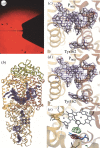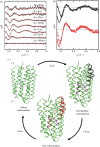Opportunities and challenges for time-resolved studies of protein structural dynamics at X-ray free-electron lasers
- PMID: 24914150
- PMCID: PMC4052859
- DOI: 10.1098/rstb.2013.0318
Opportunities and challenges for time-resolved studies of protein structural dynamics at X-ray free-electron lasers
Abstract
X-ray free-electron lasers (XFELs) are revolutionary X-ray sources. Their time structure, providing X-ray pulses of a few tens of femtoseconds in duration; and their extreme peak brilliance, delivering approximately 10(12) X-ray photons per pulse and facilitating sub-micrometre focusing, distinguish XFEL sources from synchrotron radiation. In this opinion piece, I argue that these properties of XFEL radiation will facilitate new discoveries in life science. I reason that time-resolved serial femtosecond crystallography and time-resolved wide angle X-ray scattering are promising areas of scientific investigation that will be advanced by XFEL capabilities, allowing new scientific questions to be addressed that are not accessible using established methods at storage ring facilities. These questions include visualizing ultrafast protein structural dynamics on the femtosecond to picosecond time-scale, as well as time-resolved diffraction studies of non-cyclic reactions. I argue that these emerging opportunities will stimulate a renaissance of interest in time-resolved structural biochemistry.
Keywords: X-ray free-electron lasers; serial femtosecond crystallography; structural biology; time-resolved diffraction; time-resolved wide angle X-ray scattering.
Figures


Similar articles
-
Dynamic Structural Biology Experiments at XFEL or Synchrotron Sources.Methods Mol Biol. 2021;2305:203-228. doi: 10.1007/978-1-0716-1406-8_11. Methods Mol Biol. 2021. PMID: 33950392 Review.
-
Time-resolved structural studies at synchrotrons and X-ray free electron lasers: opportunities and challenges.Curr Opin Struct Biol. 2012 Oct;22(5):651-9. doi: 10.1016/j.sbi.2012.08.006. Epub 2012 Sep 25. Curr Opin Struct Biol. 2012. PMID: 23021004 Free PMC article. Review.
-
Membrane protein structural biology using X-ray free electron lasers.Curr Opin Struct Biol. 2015 Aug;33:115-25. doi: 10.1016/j.sbi.2015.08.006. Epub 2015 Sep 3. Curr Opin Struct Biol. 2015. PMID: 26342349 Review.
-
Time-resolved crystallography and protein design: signalling photoreceptors and optogenetics.Philos Trans R Soc Lond B Biol Sci. 2014 Jul 17;369(1647):20130568. doi: 10.1098/rstb.2013.0568. Philos Trans R Soc Lond B Biol Sci. 2014. PMID: 24914168 Free PMC article. Review.
-
Sample delivery for serial crystallography at free-electron lasers and synchrotrons.Acta Crystallogr D Struct Biol. 2019 Feb 1;75(Pt 2):178-191. doi: 10.1107/S205979831801567X. Epub 2019 Jan 9. Acta Crystallogr D Struct Biol. 2019. PMID: 30821706 Free PMC article. Review.
Cited by
-
Deconvolution of dynamic heterogeneity in protein structure.Struct Dyn. 2024 Aug 19;11(4):041302. doi: 10.1063/4.0000261. eCollection 2024 Jul. Struct Dyn. 2024. PMID: 39165899 Free PMC article. Review.
-
The birth of a new field.Philos Trans R Soc Lond B Biol Sci. 2014 Jul 17;369(1647):20130309. doi: 10.1098/rstb.2013.0309. Philos Trans R Soc Lond B Biol Sci. 2014. PMID: 24914144 Free PMC article. No abstract available.
-
Ligand and interfacial dynamics in a homodimeric hemoglobin.Struct Dyn. 2016 Feb 17;3(1):012003. doi: 10.1063/1.4940228. eCollection 2016 Jan. Struct Dyn. 2016. PMID: 26958581 Free PMC article.
-
Serial femtosecond X-ray diffraction of enveloped virus microcrystals.Struct Dyn. 2015 Aug 20;2(4):041720. doi: 10.1063/1.4929410. eCollection 2015 Jul. Struct Dyn. 2015. PMID: 26798819 Free PMC article.
-
Progress in small-angle scattering from biological solutions at high-brilliance synchrotrons.IUCrJ. 2017 Aug 8;4(Pt 5):518-528. doi: 10.1107/S2052252517008740. eCollection 2017 Sep 1. IUCrJ. 2017. PMID: 28989709 Free PMC article. Review.
References
Publication types
MeSH terms
Substances
LinkOut - more resources
Full Text Sources
Other Literature Sources

